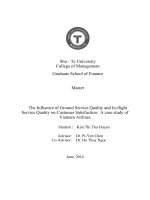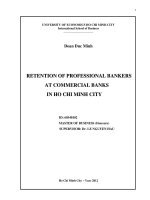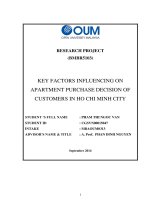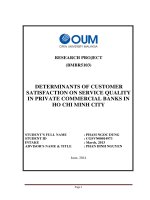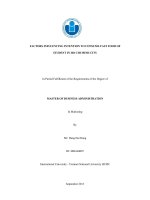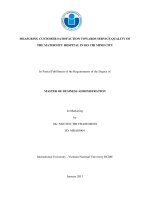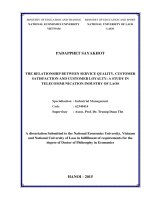The impact of bank service quality on customer loyalty a study of banks in ho chi minh city
Bạn đang xem bản rút gọn của tài liệu. Xem và tải ngay bản đầy đủ của tài liệu tại đây (1.1 MB, 88 trang )
MINISTRY OF EDUCATION AND TRAINING
UNIVERSITY OF ECONOMICS HO CHI MINH CITY
----------//---------
DO CONG BIEN
THE IMPACT OF BANK SERVICE QUALITY ON
CUSTOMER LOYALTY
A STUDY OF BANKS IN HO CHI MINH CITY
MASTER OF BUSINESS ADMINISTRATION THESIS
Ho Chi Minh City – 2011
MINISTRY OF EDUCATION AND TRAINING
UNIVERSITY OF ECONOMICS HO CHI MINH CITY
---------//---------
DO CONG BIEN
THE IMPACT OF BANK SERVICE QUALITY ON
CUSTOMER LOYALTY
A STUDY OF BANKS IN HO CHI MINH CITY
Major
: Business Administration
Major Code : 60.34.05
MASTER OF BUSINESS ADMINISTRATION THESIS
Supervisor: PROF. DR. NGUYEN DONG PHONG
Ho Chi Minh City – 2011
ACKNOWLEDGEMENT
First and foremost, I would like to thanks to my supervisor Prof. Dr. Nguyen Dong
Phong for his guidance, encouragement and excellent advice throughout this
research study.
I would like to express my heartfelt gratitude and deepest appreciation to Dr. Tran
Ha Minh Quan for his precious guidance, share of experience, and highly valuable
suggestions for this research as well during the MBA course.
I would like to especially express my thanks to Lecturer Mr. Dang Huu Phuc for his
supports and instructions in analyzing data of my thesis.
Much appreciation goes to all lecturers at Faculty of Business Administration and
Postgraduate Faculty, University of Economics Ho Chi Minh City for their
expertise in providing me continuous learning process that greatly enriched my
knowledge.
I would like to thank to all my classmates, my friends for their supports and
encouragement.
Last but not least, I would like to take this opportunity to express my profound
gratitude to my beloved parents for being patience and never failed giving me
continuous supports.
i
ABSTRACT
The purpose of this research is to assess bank service quality in Vietnam based on
perceptions and experiences of customers, to find the linkage between bank service
quality attributes, customer satisfaction and customer loyalty in retail banking sector.
This research sought to identify the most important attributes in banking settings, which
may be used to review characteristics of the banks as experienced by customers. In
Vietnam, no study has yet investigated the above mentioned interrelationship; this
research is to fill this gap.
Based on the BSQ (bank service quality) model suggested by Bahia and Nantel (2000),
six main dimensions (effectiveness and assurance, access, price, tangibles, service
portfolio, and reliability) were used to find out the relationship among bank service
quality, customer satisfaction, and customer loyalty. All the data were collected through
questionnaires; the sample size of 246 retail banking customers was drawn from
different banks in Ho Chi Minh City. Descriptive statistical approach, multiple linear
regression, Anova were then used to describe and analyze these six dimensions and take
them into the involvement with customer satisfaction and loyalty.
The results show that four bank service quality attributes (effectiveness and assurance,
access, price, service portfolio) are positively related to customer satisfaction and
customer satisfaction is positive related to customer loyalty. Access demonstrates the
highest positive correlation with customer satisfaction while two remaining attributes
(tangibles and reliability) are not positively related to customer satisfaction.
This study was one of the first ones using BSQ model to test bank service quality in retail
banking section in Vietnam. This study also suggests that BSQ (bank service quality) is a
suitable instrument for measuring the bank service quality in the Vietnamese context.
Keywords: bank service quality, customer satisfaction, customer loyalty, effectiveness
and assurance, access, price, tangibles, service portfolio, and reliability.
ii
CONTENTS
Acknowledgement …………………………………………………………….
i
Abstract ………………………………………………………………………..
ii
Contents ……………………………………………………………………….
iii
Lists of Tables …………………………………………………………………
vi
Lists of Figures ………………………………………………………………..
vii
CHAPTER 1: INTRODUCTION …………………………………………..
1
1.1 Research background ……………………………………………………...
1
1.2 Problem statement and research questions………………………………...
2
1.3 Research purposes ………………………………………………………...
4
1.4 Research scope …………………………………………………………….
4
1.5 Conceptual framework …………………………………………………….
5
1.6 Significance of the study ………………………………………………….
5
1.7 Thesis structure ……………………………………………………………
6
1.8 Summary …………………………………………………………………..
6
CHAPTER 2: LITERATURE REVIEW …………………………………..
7
2.1 Introduction ………………………………………………………………..
7
2.2 Bank service quality ………………………………………………………
7
2.2.1 Service quality concept ……………………………………………..
7
2 .2.2 Service quality attributes …………………………………………..
11
2.2.3 Critique of SERVQUAL ……………………………………………
14
2.2.4 Service quality attributes of retail banking …………………………
16
2.3 Customer satisfaction ……………………………………………………..
20
2.4 Customer loyalty ………………………………………………………….
22
2.5 Relationships between service quality, customer satisfaction and loyalty..
25
2.6 The research model and hypotheses…………………………………….....
29
2.6.1 The research model …………………………………………………
29
2.6.2 Hypotheses ………………………………………………………….
29
iii
2.7 Summary ………………………………………………………………….
31
CHAPTER 3: RESEARCH METHODOLOGY ………………………….
32
3.1 Introduction ……………………………………………………………….
32
3.2 Research design …………………………………………………………...
32
3.3 Research process …………………………………………………………..
32
3.4 Measurement scales………………. ………………………………………
33
3.5 Sample size and data collection procedures ………………………………
35
3.6 Data analysis method ...……………………………………………………
36
3.7 Summary ………………………………………………………………….
37
CHAPTER 4: DATA ANALYSIS AND RESULTS..………………………
38
4.1 Introduction ………………………………………………………………..
38
4.2 General characteristics of the sample ……………………………………..
38
4.3 Cronbach alpha reliability analysis ………………………………………..
39
4.4 Exploratory factor analysis ………………………………………………..
40
4.4.1 Factor analysis for bank service quality attributes ………………….
40
4.4.2 Factor analysis for customer loyalty variable ………………………
43
4.5 Multiple linear regression …………………………………………………
44
4.5.1 Customer satisfaction and bank service quality …………………….
44
4.5.2 Customer loyalty and customer satisfaction ………………………..
46
4.6 Hypotheses assessment and discussion …………………………………...
48
4.7 ANOVA analysis ………………………………………………………….
51
4.7.1 In the aspect of age with customer satisfaction ……………………..
51
4.7.2 In the aspect of income with customer satisfaction ………………..
52
4.8 Summary …………………………………………………………………..
53
CHAPTER 5: CONCLUSIONS AND IMPLICATIONS ………………...
54
5.1 Introduction ………………………………………………………………..
54
5.2 Conclusions ……………………………………………………………….
54
5.3 Managerial implications …………………………………………………..
55
5.3.1 Customer satisfaction…..……………………………………………
56
iv
5.3.2 Access ………………………………………………………………
56
5.3.3 Effectiveness and assurance ………………………………………..
56
5.3.4 Price …………………………………………………………………
57
5.3.5 Service portfolio …………………………………………………….
58
5.4 Limitations ………………………………………………………………..
59
5.5 Recommendations for future research …………………………………….
59
5.6 Summary …………………………………………………………………..
59
REFERENCES ………………………………………………………………
61
APPENDIX 1: Overview of retail banking sector in Vietnam ……………
65
APPENDIX 2: Data analysis ………………………………………………..
66
APPENDIX 3: Questionnaires ………………………………………………
74
v
LISTS OF TABLES
Table 2.1
The definition of five services quality attributes ……………..
14
Table 2.2
The definition of five services quality attributes ……………..
19
Table 3.1
The main measurement scales of the research………………..
34
Table 4.1
Personal Profile of Respondents ……………………………..
38
Table 4.2
Cronbach’s Alpha results for main survey ……………………
39
Table 4.3
KMO and Bartlett’s Test (Bank service quality) ……………..
41
Table 4.4
Total variance explained (Bank service quality) ……………..
41
Table 4.5
EFA rotated component matrix (Bank service quality) ……….
42
Table 4.6
KMO and Bartlett’s Test (Customer loyalty) …………………
43
Table 4.7
Total variance explained (Customer loyalty) …………………
44
Table 4.8
Component matrix (Customer loyalty) ……………………….
44
Table 4.9
Model summary (Customer satisfaction) ……………………..
45
Table 4.10 ANOVA (Customer satisfaction) …………………………….
45
Table 4.11 Coefficients (Customer satisfaction) …………………………
46
Table 4.12 Model summary (Customer loyalty) ………………………….
47
Table 4.13 ANOVA (Customer loyalty) ………………………………….
47
Table 4.14 Coefficients (Customer loyalty) ………………………………
47
Table 4.15 Results of hypotheses test ……………………………….........
50
Table 4.16 Descriptive of age on customer satisfaction ………………….
51
Table 4.17 ANOVA (Age and customer satisfaction) …………………….
51
Table 4.18 Descriptive of income (Customer satisfaction) ……………….
52
Table 4.19 ANOVA (Income and Customer satisfaction) ………………..
52
vi
LISTS OF FIGURES
Figure 1.1
Figure 2.1
Figure 2.2
Figure 2.3
Figure 3.1
The conceptual model of the performance of service quality
attributes, customer satisfaction and customer loyalty adopted
from Caruana (2002) and Cronin et al. (2000)……………….
The conceptual model of service quality by Parasunaman et
al. (1985) ……………………………………………………..
The research model of service quality, customer satisfaction
and service loyalty by Caruana (2002) ……………………….
Research model ………………………………………………
Research process...……………………………………………
vii
5
10
27
29
33
CHAPTER 1: INTRODUCTION
1.1 Research background
Within the last two decades, service quality has become an interesting topic in the
industrial world, especially in the service industries. The key to success in winning
the global competition now and in the future is to have a high quality service. High
quality of service is believed to influence over customer satisfaction, and
furthermore customer satisfaction will impact on customer loyalty. Therefore, the
importance of service quality, customer satisfaction seems justified to the survival
of service firms, including the banking firms in terms of retaining customer’s
continuation to do business.
Many empirical researches in various sectors of service industry such as banking,
hotel, telecommunication, insurance, finance leasing, workshops, car rental and
leasing, and other financial companies have been conducted to find out the main
factors that determine service quality. Service quality has always been the main
study for retail banking in a very competitive environment today in which a lot of
banks are available for customers to choose from. However, we need to learn
further the important factors that enable banks to attract and retain their customers.
Banks seeking strong competition in the future need to develop new ideas to
improve good relationships with their customers.
The retail banking sector of Vietnam is expected to have one of the highest growth
rates in Asia area market during the next few years because the country’s continues
economic expansion, increasingly household incomes, abundant resources and
relatively low penetration of existing banking services. Over the past two decades,
the Vietnamese government has undertaken a series of reforms to strengthen and
modernize the banking system as part of the country’s trend of moving towards a
more open and market-oriented economy. Many of these reforms have also been
motivated by Vietnam’s growing participation in international agreements and
ongoing efforts to adopt international standards. Some important reforms include a
1
restructuring of the banking system, a gradual opening to foreign investment to
foreign partners, the partial privatization of state-owned banking institutions,
mergers and acquisitions (M&A), and measures to strengthen the capitalization of
some big Vietnamese banks. Furthermore, Vietnam’s rapid economic growth has
contributed to rising household and an increasing demand for retail banking service.
Credit and debit card use has become more common, with the number of cards
issued doubling between 2008 and 2010 to 28.5 million (Yao and Carroll, 2011).
The number of automated teller machines (ATMs) has also climbed dramatically.
The banking sector in Vietnam is divided into four primary types of institutions.
These include six state-owned commercial banks (SOCBs), 37 joint-stock
commercial banks (JSCBs), five joint-venture banks, and five wholly foreignowned banks (Yao and Carroll, 2011). Services offered by the bank may include
deposit services, consumer loans, credit facilities (credit cards and debit card),
electronic banking, and even convenient location, convenient time, pleasant
ambience, financial products’ assortment, service information, accessible services,
and friendly and helpful assistance. The emergence of new forms of banking
channels such as internet banking, ATMs, phone banking and also maturing market
and global competitiveness have forced bankers to explore the high importance of
customer loyalty. The banking industry is widely affected by the movement towards
globalization and internationalization, and so it is characterized by very strong
competition. In Vietnam, banks increasingly play more and more important role in
the economic structure, which leads to a demand of measuring and improving
service quality in banking as a main point of fact. Therefore, the conceptualization
of service quality and measuring bank service quality has emerged as major
challenges for financial services and banks in Vietnam now and in the future.
1.2 Problem statement and research questions
Although study in the service quality of retail banking based on customer
perception has conducted widely, no recent researches have been conducted which
2
examine the effect of bank service quality dimensions on customer satisfaction
directly and loyalty indirectly in an integrated model in Vietnam context.
The improvements of service delivery in banking business are expected to influence
the service quality, customer satisfaction, and service loyalty. On the other hand,
customers are going to use a variety of service dimensions that are salient to the
customer to infer the bank service quality. These service attributes play an
important role within service encounter, since they serve as indicator of service
quality.
This study attempts to examine the effect of service dimensions on perceived
service quality, customer satisfaction, and customer loyalty based on the estimated
research questions which presented as follows:
1. What are the key service quality dimensions of bank that determine
satisfaction of customers in the retail banking sector in Ho Chi Minh City?
By addressing this question, managers who are working in banking sector
can identify their strength and weakness to drive their investment in a right
direction.
2. What are the specific predictors that affect the customer loyalty in retail
banking sector in Ho Chi Minh City?
By addressing this question, managers who are working in banking sector
can identify their strength and weakness to drive their investment in a right
direction to retain customer retention.
3. How important each bank service quality dimension placing on general
customer satisfaction, customer loyalty in the retail banking sector in Ho Chi
Minh City?
Resolving this question will assist banks to prioritize their investment for a
marketing communication program. Moreover, new banks or banks with
limited budget can find it useful to firstly spend money for some important
factors in a short-term development.
3
4. How the proposed model contributes in the retail banking sector in Vietnam?
Resolving this question will assist banks to use a suitable instrument for
measuring the bank service quality in Vietnam context.
1.3 Research purposes
Based on the research questions, this study was implemented to identify the bank
service quality drivers of customer loyalty to achieve the following objectives:
(1) Explore the impact of bank service quality dimensions such as bank
convenience, physical facilities, perceived price, employee service, service
portfolio, reliability, access, effectiveness and assurance on customer
satisfaction.
(2) Explore the impact of customer satisfaction on customer loyalty.
(3) Qualify the importance level of each independent factor (bank service
quality) in the relationship with customer satisfaction and linkage between
customer satisfaction and customer loyalty.
(4) Find a suitable instrument for testing the bank service quality in Vietnam
banking context.
1.4 Research scope
The research was conducted in Ho Chi Minh City, a commercial and financial
trading center of Vietnam. Ho Chi Minh City has been chosen for this research due
to its centricity for Economic and Industrial activities and being a silicon valley for
many other activities (such as culture, education, sport) in which requires active
banking transactions very much.
The study focuses on famous banks in Ho Chi Minh City such as Vietcombank,
Vietinbank, BIDV, Techcombank, HSBC bank, ANZ bank, Eximbank, Dong A
Bank, and ACB.
4
1.5 Conceptual framework
The conceptual framework of this study is mainly based on definitions and theories
of the BSQ [Bank Service Quality] instrument (Bahia and Nantel, 2000) which is
relied on the SERVQUAL approach (Parasuraman et al., 1988).
Cronin et al. (2000) both synthesized and built on the efforts to conceptualize the
effects of quality, satisfaction, and value on customers’ behavioral intentions.
Caruana (2002) developed a model of how service quality affects service loyalty,
mediated by customer satisfaction. This study used these hypothesized relationship
presented in Figure 1.1 to develop the model of this research.
Performance of
Service Quality
Attributes
Customer
Satisfaction
Customer
Loyalty
Figure 1.1: The conceptual model of the performance of service quality attributes,
customer satisfaction and customer loyalty adopted from Caruana (2002) and
Cronin et al. (2000).
1.6 Significance of the study
In Vietnam context, the empirical studies of the relationship among service quality,
customer satisfaction and customer loyalty for banking system are limited, the
existing studies on banks also do not account for the changing roles of bank setting
system in Vietnam’s economic structure. Service quality is one of the highest
important factors in analyzing the performance of banks, since their survival
depends on their service quality levels they provide for their customers (Poretla and
Thanassoulis, 2005). Having a good way in supplying high quality services is a key
to achieve customer loyalty which is the primary goal of business organizations, due
to the advantages of customer retention (Ehigie, 2006). Today, the increasing
awareness among bank customers of their rights, changing demands and highly
5
competition requires constant progress in service quality from the bank for their
customers to stay loyal. The present research intends to test whether the bank
customers are happy with the services provided to them, which will eventually lead
customer loyalty or not.
1.7 Thesis structure
The content of this thesis is as follow:
Chapter 1 – Introduction: briefly introduces about research background, problem
definition, research questions, research objectives, scope of research, significance of
the research, theoretical framework, and study structure.
Chapter 2 – Literature Review: provides an overview of the previous literature on
bank service quality in order to understand the key service quality drivers of
customer satisfaction and customer loyalty; the different impacts of each bank
service quality dimension on customer satisfaction and overall loyalty outcomes.
The chapter also reviewed various preceding studies about service quality, bank
service quality, customer satisfaction and customer loyalty before releasing the
theoretical model and research hypotheses.
Chapter 3 – Research Methodology: explains the methodology used to assess the
research model and the hypotheses. Sampling method, sample size, target
respondents and data analysis method are also covered in this chapter.
Chapter 4 – Data Analysis and Results: represents the key findings of the sample
characteristics. This chapter also comprises statistical procedures that were
undertaken to test hypotheses and reveals the applicable model.
Chapter 5 – Conclusion and Implications: includes conclusions, managerial
implications, research limitations and future research.
1.8 Summary
This chapter provides the background of the study, statement of the problem, ,
research questions, purposes of the study, and previous theoretical framework. It
also represents the scope and the structure of this study.
6
CHAPTER 2: LITERATURE REVIEW
2.1 Introduction
This chapter presents the theoretical foundation, based on the previous literature
appropriate to the current research, by first reviewing the service quality concepts,
service quality attributes, followed by a critique of SERVQUAL, specified service
quality attributes of retail banking, and introduction of BSQ [Bank Service Quality]
model. Next, a review of literature related to customer loyalty, and customer
satisfaction is also presented. This is followed by a review of researches conducted
on relationship between service quality, customer satisfaction, and customer loyalty.
The development of a research proposal and hypotheses that result for the critical
review of previous studies is the last section of this chapter.
2.2 Bank service quality
2.2.1 Service quality concept
A service is a complicated phenomenon. It has many meanings, ranging from
personal service to service as a product. During four decades, there are variety
definitions of services. Gronross (1990) proposed the definition of service as
follows:
“A service is an activity or series of activities of more or less intangible nature that
normally, but not necessarily, take place in interactions between the customer and
service employees and/or physical resources or goods and/or systems of the services
provider, which are provided as solutions to customer problems.”
In line with Gronross, many writers described that for most services, there are four
basic characteristics that differentiate them from manufacturing as follow:
1) Services are more or less intangible.
2) Services are activities or series of activities than things.
3) Services are at least to some extent produced and consumed simultaneously.
4) The consumer participates in the production process at least to some extent.
7
For a full understanding of service quality, these characteristics of services such as
intangibility, heterogeneity, and customer participation in the production process
must be acknowledged.
Before discussing service quality concept, it is important to discuss service
encounters, because within the service encounters, the interactive and interpersonal
participation of customer and service providers becomes critical when judging
service quality.
Shostack (1985) defined the service encounter as “a period of time during which a
customer directly interact with a service”. This definition contains all aspects of the
service company with which the customer may interact, including it personnel, its
physical facilities, and other visible elements. It means that the definition does not
only limit the encounter to the interpersonal interactions between the customer and
the firm, but the service encounters can also without any human interaction element.
There are three types of service encounters: remote encounters, phone encounters,
and face to face encounters (Shostack, 1985). Remote encounters occur when a
customer interacts with the service firm without any direct human contact, such as
when customer interacts with a bank through the ATMs or internet system. Phone
encounters occur when the interaction between the end customer and the service
firm occurs over the telephone, such as when customer interacts with a bank
through the phone banking system. Face to face encounters are ones that occurs
between a customer and an employee in direct contact, such as when bank customer
interacts with the teller or customer service in a branch.
The interactive and interpersonal participation of customer and service providers
become critical when judging service quality. Other elements that are also critical
for judging service quality include: physical surroundings and tangible cues,
participant’s involvement and process of service delivery.
Parasuraman et al. (1985) stated that service quality is more difficult for the
customer to evaluate than goods quality. When customers purchase goods, they
engage many tangible cues to judge quality such as style, hardness, color, label, and
8
package. When they purchase services, fewer tangible cues exist, such as service
provider’s physical facilities, equipment and personnel. In the absence of tangible
cues customers must depend on other cues to judge quality, such as price, service
portfolio.
Gronross (1984) defined service quality as the fulfillment of customers’ satisfaction.
He explained that service quality as it is perceived by customers consists of
technical quality, functional quality, and corporate image. Technical quality
involves what the customer is actually receiving from the service. Functional
quality involves the manner in which the service is delivered. Technical quality
focuses on “what”, while functional quality focuses on “how” and involves
consideration of issues such as the behavior of staff contacting customers, and the
speed of services. Corporate image is a reflection of service organization.
Furthermore, Gronross (1990) stated that corporate image can impact the perception
of quality in various ways. If the provider is good in minds of the customers, minor
mistakes will probably be forgiven. Otherwise, if the provider is not good in the
minds of the customers, the impact of any mistake will probably not be forgiven.
Parasuraman et al. (1985) undertook an exploratory qualitative study to investigate
the concept of service quality. The focus group interviews with consumers and indepth interviews with executives. Based on their research, they proposed the service
quality model as displayed in Figure 2.1.
9
CUSTOMER
Word of Mouth
Communications
Personal Needs
Past Experience
Expected Service
Gap 5
Perceived Service
MARKETER
Gap 4
Service Delivery
Gap 3
Gap 1
External
Communications to
Customers
Service Quality
Specifications
Gap 2
Management
Perceptions of
Customer
Expectations
Figure 2.1: The conceptual model of service quality by Parasunaman et al. (1985)
The gaps revealed by the executive interviews are shown in the lower portion of
Figure 2.1 (the marketer side), and the gaps revealed by the customer interviews are
shown in the upper portion of Figure 2.1 (the customer side). According to the
proposed model, there are five gaps including: (1) customers’ expectations and
10
managements’ perceptions gap, (2) managements’ perceptions of customer
expectations and service quality specifications gap, (3) service quality specifications
and service delivery gap, (4) service delivery and external communications gap, (5)
customer’s expected service and customer’s perceived service performance gap.
The above gap model in Figure 2.1 shows that four gaps on marketer’s side affect
the level of service quality as perceived by customers. Parasuraman et al. (1985)
showed that customers used criteria in evaluating service quality. These criteria are
labeled as “service quality determinants” including: reliability, responsiveness,
competence, communication, access, courtesy, credibility, security, understanding
or knowing the customers, and tangibles
After they established a conceptual definition of service quality and the ten
dimensions from their exploratory research, Parasuraman et al. (1988) embarked on
a quantitative research phase to develop an instrument for measuring consumers’
perception of service quality, later the instrument became known as SERVQUAL.
They defined service quality as the difference between a customers’s expected
service with the perception of service received. The position of customer’s
perception of service quality depends on the nature of the discrepancy between the
expected service and perceived service including: (i) expectations of service quality
are not met: service quality is unacceptable or less than satisfactory, (ii)
expectations of service quality are met: service quality is acceptable or satisfactory,
(iii) Expectations of service quality are exceeded: performance exceeds
expectations.
2.2.2 Service quality attributes
Olson (1977) has distinguished service quality into intrinsic and extrinsic cues.
Intrinsic cues are attributes that are part of the physical composition of the product,
for example flavor, color, freshness, size, fit, and style. They cannot be changed
without changing the nature of the product and are consumed along with the
product. Extrinsic cues are attributes relating to the product, but actually they are
not product. They can serve as general indicators of quality across all types of
11
product. Examples of extrinsic attributes include price, brand name, and level of
advertising.
Previous studies (Zeithaml, 1988) suggested that intrinsic attributes can be more
important to customers than extrinsic attributes in the following situation:
(1) During consumption of the product;
(2) In pre-purchase situations when customers are actively search for intrinsic
attributes;
(3) When the intrinsic attributes have high predictive value to judge quality.
In the contrasting way, extrinsic attributes can be more important than intrinsic
attributes when we consider:
(1) Customer is in initial purchase situation, in which intrinsic attributes are not
available;
(2) Customer has insufficient time or interest to evaluate the intrinsic attributes;
(3) Quality is difficult to evaluate.
Whereas previous study that examined attributes used by customers to infer quality
of tangible goods have been studied extensively, very little research has examined
cues within service environment (Hartline and Jones, 1996). Because services are
intangible, customers are more likely to use intrinsic cues to infer service quality
prior to the actual purchase and consumption of the service. As a result, attributes
such as price, brand name, advertising, word-of-mouth, and certain tangible service
elements are important to customers as they attempt to judge the quality of a service
prior to consumption (Parasuraman et al., 1985; Hartline and Jones, 1996).
Parasuraman et al. (1988) found consistent attributes of perceived service quality
across the four service industries with five dimension including reliability,
responsiveness, assurance, empathy, and tangibles.
In a period during the service delivery process, the customer is directly interacting
with the personnel, physical facilities and other elements such as communication
materials. Because services are intangible, consumers use tangible clues as proxies
12
in evaluating the quality of services. If customer perceives that the appearance of
physical facilities, equipment, personnel, and communication materials are good,
then his or her judgment will be positively affected. Parasuraman et al. (1988) refer
to this as “tangibles”.
The attribute termed “reliability” is associated to the ability of the service provider
to perform the promised services dependably and accurately. Reliability is closely
related to the concept of technical quality of service. The other attributes such as
tangibles, responsiveness, assurance, and empathy are related to the concept of
functional quality (Gronross, 1984).
The “responsiveness” attribute of service quality refers to whether the service
provider has the willingness to help customers and provide prompt service
(Parasuraman et al., 1988). When the service provider provides prompt service to its
customers, the customer perceives that he or she is receiving good quality.
Customers frequently find difficult to evaluate the quality of the service if they have
not experienced yet the particular service. It is believed that the level of customer’s
trust play important role in assessing the quality of the service provided by the
service provider. The more the customer trusts the service provider, the better the
customer’s perception on the service quality. The attribute termed “assurance” is
associated with the ability of the service provider to convey trust and confidence to
the customers (Parasuraman et al., 1988).
Finally, if customers perceive that they are not receiving concerned, personal, or
individual attention from the service provider, then their quality judgment will be
negatively affected. Parasuraman et al. (1988) refer to this as “empathy”. A brief
description of each attribute is presented in Table 2.1:
13
Table 2.1: The definition of five services quality attributes
Attributes
Definition
Physical facilities, equipment, personnel, and
appearance of personnel.
Ability to perform the promised service dependably
Reliability
and accurately.
Willingness to help customers and provide prompt
Responsiveness
service.
Knowledge and courtesy of employees and their
Assurance
ability to convey trust and confidence.
Caring, individualized attention the firm provides its
Empathy
customers.
Tangibles
The number
of items
4
4
4
5
5
Source: cited from Parasuraman et al., 1988
2.2.3 Critique of SERVQUAL
The most popular model for evaluation of service quality is SERVQUAL, a wellknow scale developed by Parasuraman et al. (1985, 1988). The attributes of
(Parasuraman et al., 1985) were: tangibles, reliability, responsiveness, competency,
courtesy, assurance, credibility, security, access, and understanding. Parasuraman et
al. (1988) later reduced these ten dimensions into five by using a factor analysis.
Based on the five dimensions, a 22-item survey instrument for measuring service
quality has been developed. These five dimensions are: tangibles, reliability,
responsiveness, assurance, and empathy.
There has been criticism from some other researchers to SERVQUAL instrument.
Firstly, many researches and papers have used SERVQUAL scale to verify and to
adjust in conformity with many different market situations and conditions.
Secondly, SERVQUAL approach covers every specific matter involving into
service quality rather completely.
Carman (1990) suggested that the five dimensions of SERVQUAL are not
consistent when subjected to cross sectional analysis. He found that some of the
items did not load on the same component when compared across different type of
service providers, but the validity of the 22 items that make up the SERVQUAL
scale appears to be well-supported both by the procedures used to develop the items
14
and the subsequent use as reported in the literature. Further, Carman noted that there
is an operational problem with the difference of expectations and perceptions
concept (gap concept). He suggested an alternative format combining both
expectations and perceptions to a single item. The items with this format would be
presented with anchors “greatly exceeds of my expectations” and “greatly falls short
of my expectations”. This format would be simpler for respondents and prevent
potential problems with the gap scores.
The five dimensions of SERVQUAL are not sufficiently generic. Carman (1990)
found that it is often necessary to incorporate additional items to dimensions
because they are particularly important for some service categories. A further
critique addressed to SERVQUAL concerns its emphasis on service or product
dimension and its neglect of the other dimensions of the marketing mix. In other
words, indeed, academics and practitioners in both services and physical goods
marketing have focused on the first P (service and/or product) of the marketing mix
to improve quality, but neglected other dimensions of the marketing mix, especially
price. Therefore, it means that this is not sufficient to cover all the facets of quality.
As suggested by Carman (1990), Babakus and Boller (1992) maintained that the
dimensionality of service quality might depend on the type of services under study.
In addition, they found that a number of methodological problems likely exist with
SERVQUAL, due to the wording of the items and defining a construct on the basic
of the gap scores. The agreed with Carman’s suggestion that an alternative format
combining both expectations and perceptions to a single item may prove a viable
approach.
Cronin and Taylor (1992) criticized SERVQUAL for the conceptualization and
measurement of service quality. They argued that theoretically, if service quality
was to be considered “similar in many ways to attitude”, as proposed by
Parasuraman et al. (1985, 1988), its operationalization could be better represented
by an attitude-based conceptualization. Therefore, they suggested discarding the
15
expectations portion of SERVQUAL in favor of just the performance measures
included in a scale that they termed SERVPERF.
Parasuraman et al. (1991, 1993) affirm that SERVQUAL is a full measurement
scale toward service quality and suitable to apply to all kinds of services. However,
each kind of specific service has its own traits and characteristics. Some abovementioned researchers also suggested that the dimensionality of service quality
might depend on the type of services under study. It is necessary to have more
researches in order to explore model service quality in each service field and in each
specific market. There are some researchers conducting service quality research in
retail banking setting, in which they modified the service quality dimensions to fit
the bank specific characteristics.
2.2.4 Service quality attributes of retail banking
In order to develop marketing strategy, service providers, especially bank managers
need to understand the service attributes that used by customers in selecting bank.
For example, customers would use bank reputation, bank reliability, bank
assurance, price, kind of services, and physical facilities of the bank in selecting
bank services. If bank managers can understand which attributes are used to
evaluate a service, they will be better able to manage and influence the customer’s
evaluation and perception of the offering (Crane and Clarke, 1988).
Perceived service quality is a customer judgment and results from comparisons
customers make between their expectation and their perception of the actual service
performance (Lewis, 1989). Thus, in the banking sector, perceived service quality
results from the difference between customers’ perceptions for the services offered
by the bank and their expectation visa the banks that offer such service (Bahia and
Nantel, 2000). Perceived quality of service tends to play an important role in high
involvement industries like banking services. In the continuous development of
technology in banking industry today, such as the advent of automatic teller
machines (ATMs), service quality may well be measured in terms of both personal
support and technical support.
16

